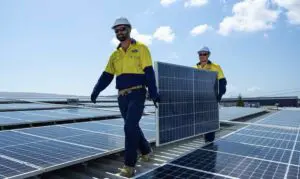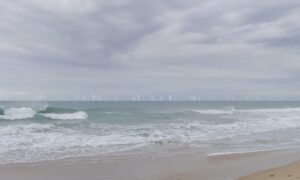The Queensland Labor government has long held an ambiguous relationship with the coal and gas industry – its support for the Adani coal project, for instance, sits uncomfortably with its push for a 50 per cent renewable energy share.
But at least now it is finally starting to crack down on one of the most open secrets of the local energy market – the rampant profiteering of its own fossil fuel generators that have been solely responsible for the unprecedented surge in electricity prices over the last two years.
The big energy initiative unveiled this week by the Palaszczuk government includes two major components. One is a huge investment in renewable energy and jobs to help meet that 50 per cent target, a recognition that the state is not solely dependent on new big coal mines for regional growth and prosperity.
The other is the decision to instruct its biggest state-owned fossil fuel generation company, Stanwell, to change its bidding practices, along with a decision to create a third government-owned generation company, this one dubbed “CleanCo” that will house hydro assets, new wind and solar projects and possibly some biomass, and will act as a new source of competition in the market.
The idea is to force wholesale prices, which have jumped by more than double in the past 18 months, back down to manageable levels. Already, the proposals have had an impact, with the futures prices for 2018 electricity prices dropping 15 per cent in a single day (on Monday).
The bidding practices from the government-owned Stanwell and CS Energy have become something of a bad joke since the manipulation of the 30-minute rule was first identified in 2015, and the impact has been chronicled by the Australian Energy Regulator and others ever since.
The government refused on Monday to concede that the generators had been “price gouging”, blaming the structure of the National Electricity Market for the bidding behaviour. It’s all been perfectly legal, if a little unsavoury.
Still, energy minister Mark Bailey says the government now “wants to see some changes in bidding behaviour”, in effect to think about consumers, rather than the government business bottom line.
At least the government is in a position to do so, if a little belatedly. South Australia has lamented the profit motive over the interests of consumers that saw similar bidding practices, and the extraordinary sight of a unit of the state’s most efficient gas generator sitting idle while rolling blackouts were imposed in February.
 Queensland, as the Australian Energy Regulator’s state of the energy market report highlighted last week, has the biggest concentration of generation assets in the state, with Stanwell and CS Energy holding a combined 65 per cent of total generation, giving them the ability to control the market, and prices.
Queensland, as the Australian Energy Regulator’s state of the energy market report highlighted last week, has the biggest concentration of generation assets in the state, with Stanwell and CS Energy holding a combined 65 per cent of total generation, giving them the ability to control the market, and prices.
The AER notes that the Queensland market and the South Australia market are both nearing the level of 2,500 on the so-called Herndahl–Hirschman index, a measure of competition.
A HHI value of 2000 is used by the Australian Competition and Consumer Commission (ACCC) to flag competition concerns, which makes it a little bizarre that the ACCC recently branded bidding strategies as the “market at work.”
As a result, the largely coal-based grid, which until the opening of the 20MW Barcaldine solar farm this year had no large-scale wind or solar, is one of the most expensive in the world, with regular price surges over summer – even more than the supposedly volatile “renewable” state of South Australia.
The AER and some network operators have both complained of observed bidding practices across Australia, including the deliberate withholding of capacity and the rebidding from low to high prices. SA Power networks called it deliberate manipulation.
As ITK analyst and RenewEconomy contributor David leitch has pointed out, amid these high prices the Wivenhoe Dam has been virtually unused. The government shift to a “CleanCo” could use this asset and other renewables to help moderate prices.
(The government also announced the forced re-opening of the Swanbank gas generator, but this is for decoration purposes only. If the government owned generators wanted more capacity, they could have used Wivenhoe).
And the Queensland government is certainly about to get a huge influx of renewable energy projects in coming years. Already, some 17 different solar projects with 1200MW of capacity are under construction.
A government list provided to RenewEconomy highlights a further 36 (mostly solar) projects, but also including wind, hydro and biomass, that are in the pipeline – amounting to a potential 4,200MW.
As the independent report into the state’s renewable energy target points out, these additions should end up being cost neutral (at work) to consumers.
It is difficult to imagine it being anything else, given that wind and solar can both be built at much lower costs than the average wholesale price of more than $100/MWh these past 12 months.
The Queensland government says it is still firmly committed to its 50 per cent renewable energy target, but will take a rain check on how to get there.
It has been given three different scenarios – linear, ramp and boost – to meet the target of 8,400MW of new renewable capacity, but now says it will wait to see the dust settle on the Finkel Review and the federal government’s climate policy review before deciding how to go forward.
But given the amount of wind and solar projects already in the pipeline – and its decision this week to conduct auctions for around 400MW of renewable energy projects (including 100MW of storage) – then it seems that the 2020 component of its 2030 target will be met with ease.










